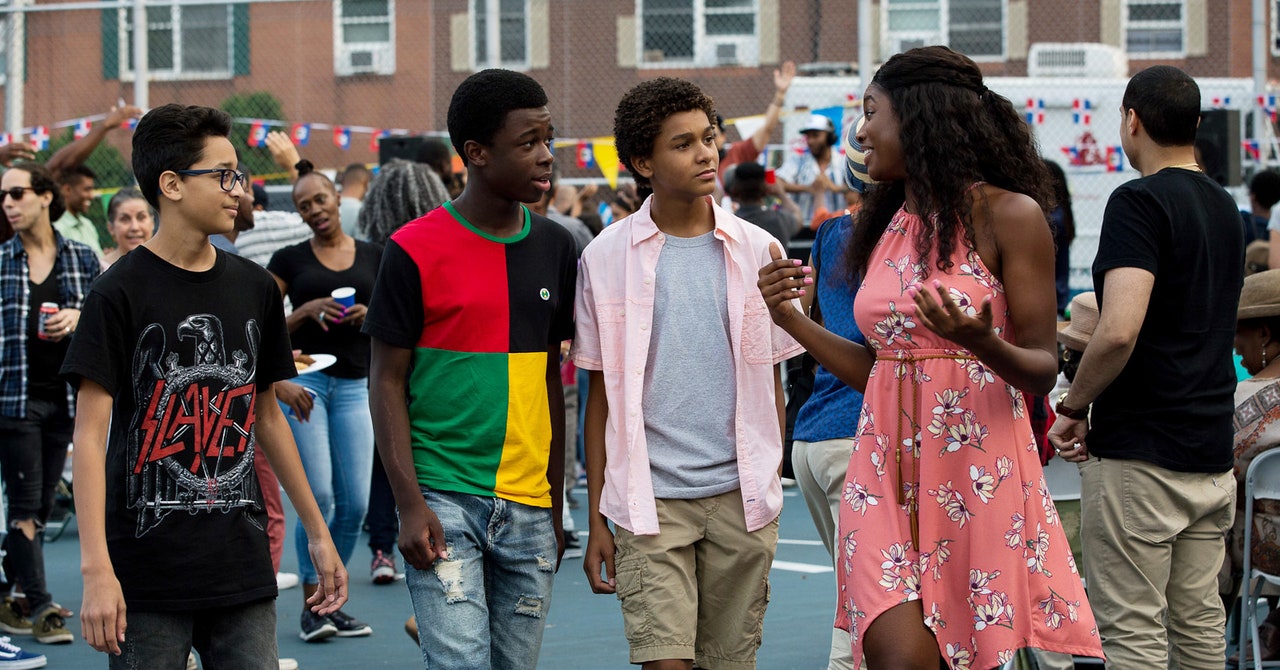
Fast-forward through the latest Netflix movie Vampires vs. the Bronx and you’ll quickly see all the markers of a campy kids’ flick, just like the ’80s used to make. There’s a tweenaged protagonist who spends a lot of time peddling around on a bicycle attempting to save local institutions adults have given up on. There’s a group of youngsters who discover a sinister, supernatural plot—one their parents and law enforcement think they’re making up. Oh, and their neighborhood is crawling with hissing vamps with angular, Buffy-style brow ridges and low-budget flight capabilities that can be dispatched with household items like mop handles, holy water balloons, and garlicky Adobo seasoning. It’s a lot like Stranger Things or It or The Lost Boys, but in tone hews much closer to The Goonies. Its tropes are classic, but you’ve probably never seen them like this.
The movie follows Miguel Martinez—known around town as Lil Mayor—as his neighborhood disappears around him. His world is bilingual, Black and brown, and centers around a beloved bodega imperiled by rising rent. One by one, nail salons and other local businesses disappear, replaced by signs promising $9 coffee or small batch butter. People are disappearing, too. A white woman moves in, buys hummus, and promises not to call the cops to complain about noise. Martinez hopes to save the bodega with a block party fundraiser, but soon discovers that his problems are bigger than just gentrification. The real estate company behind all these shuttered businesses and bougie new development plans isn’t just a figurative bloodsucker. Its staff are the real deal.
The best and worst thing about Vampires vs. the Bronx is that it’s a little formulaic. Boys fight monsters in a lot of movies, and the standard script has pitfalls, some of which Vampires vs. the Bronx stumbles directly into. It’s heavy on exposition and light on character development. It could have given more agency to its women and girls, and it escapes a totally unearned love story so narrowly that I’m not sure it counts. But Boys vs. Monsters isn’t the only cinematic formula the movie draws upon. The other one, obviously, is the vampire film. Not necessarily the sparkly Stephenie Meyer kind of vampire film. The Dracula kind.
Most recent adaptations of vampire lore have focused on only one of the anxieties Bram Stoker’s Dracula personified: sex, and liberated female sexuality in particular, which Stoker’s Victorian British readers were in quite a tizzy about at the time. Minus one vague romantic subplot, Vampires vs. the Bronx is entirely sexless, giving the movie room to explore Stoker’s other, more poignant themes. OG Dracula wasn’t just a hot dude sucking swooning maidens’ necks; he was an invader, a remnant of decadent Eastern European aristocracy, arriving in London to exploit goodhearted middle-class British folk. (For the record, Stoker’s bloodsucker was never sexy—he was a hairy-palmed old man. Hollywood made him mysterious and alluring.) In the late 19th century, when Dracula was written, the nervousness about fallen aristocrat invaders had a lot to do with people from British colonies coming to settle in the UK, but it’s since resonated with other generations for entirely different reasons.
Vampire stories seem to do best in times of economic downturn. They peaked first around the Great Depression with the classic old Hollywood films, and then again in the 1960s and ’70s, when recession (and the Cold War) made an Eastern European villain especially appealing. Twilight hit theaters in 2008, just in time for the financial crisis. Maybe this happens because the Dracula story can be understood as a kind of class struggle. Karl Marx certainly read it that way. Capital is soaked with bloody vampire metaphors. “Capital is dead labour, that, vampire-like, only lives by sucking living labour, and lives the more, the more labour it sucks,” Marx writes. So maybe vampires trend when middle and working class people feel like the rich are trying to suck the life out of them in one way or another, even if, in the Twilight paradigm, the goal is to join the undead aristocracy rather than drive a stake through its heart. Vampires vs. the Bronx fits too neatly into this part of the classic vampire narrative for it to have been an accident.
